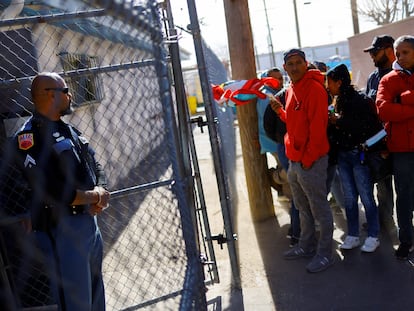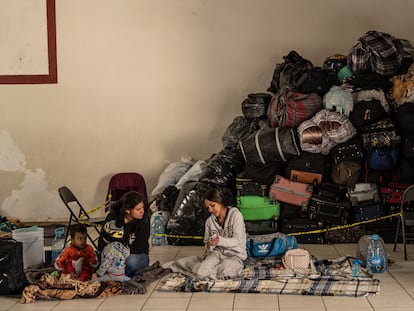The new obstacles for migrants trying to reach the US border: ‘They rob us on the bus and the police extort us’
Hundreds of people are sleeping next to the Northern Bus Station in Mexico City, after the rail border crossing into the United States was shut down


After arriving in Mexico from Ecuador, Pedro is thinking about how to get to the U.S. border.
He’s sitting outside the Northern Bus Station in Mexico City, watching his friend cook a rice casserole over some embers. On Friday, September 22, the area is populated with dozens of tents. They’ve been set up by migrants, who sleep on the asphalt that surrounds the terminal.
Suddenly, Pedro blurts out what’s on his mind. “If we go by bus, we have to pay the alcabalas [bribes to the police]. Some friends of mine [who went earlier] say that the cops take between 400 and 500 pesos [$25 or $30] several times each trip.” The other option is tougher. “If we hop on top of the train, I know we’re not going to pay anything, but there’s the risk that something could happen to us.”
The situation faced by 31-year-old Pedro is similar to that of many migrants who have settled near the bus station. They moved here after Ferromex — the company owned by Germán Larrea, the second-richest man in Mexico — discontinued numerous train routes last Tuesday, due to the presence of up to 4,000 migrants holding onto its wagons, in an attempt to reach the northern border. Added to this is that Governor Maru Campos — who administers the Mexican state of Chihuahua, one of the gateways to the United States — brokered an agreement this past Friday between the railway company and the National Migration Institute, to discourage migrants from passing through her state.

The numbers of migrants trying to cross the U.S.-Mexico hasn’t stopped rising, with numbers now higher than before the pandemic. More than 91,000 family members (officially defined as at least two people with direct relations who migrate) were detained in August when they tried to cross illegally, according to data from the United States Customs and Border Protection agency.
Between doubts about whether to take the train or the bus, Pedro knows that the path that has taken him to Mexico City is just the prelude to what awaits him as he tries to reach the northern border. “In Mexico, the problem is extortion. If you travel without documentation, the police take your money. If you don’t have money, they take your phone. And, if you don’t have anything, they send you back to the border with Guatemala,” he explains. He accuses the authorities of being well-aware that buses transport migrants and of stopping them at various points along the way. “I would prefer to cross the Darién Gap a thousand times than to cross Mexico once,” he emphasizes.
Pedro — after leaving Santo Domingo de los Colorados, the Ecuadorian city where he lived — crossed all of Central America and arrived in Mexico through Tapachula, a city in the state of Chiapas, which borders Guatemala. There, last Monday, a group of migrants tried to force their way into the Mexican Commission for Refugee Assistance. Crowds of up to 6,000 people were languishing outside.
The next step for this migrant is to reach the U.S. But CBP One — an application to request asylum in the United States — “takes a long time.” Pedro wants to reach Sonora, a border region that he considers more feasible as a point of entry. “We may be better off turning ourselves over to the American police once we cross the border,” he shrugs. Following arrest on American soil, this method — the result of a backlog of migrants waiting to be detained — consists of the migrants purchasing transportation to the homes of relatives or acquaintances in the U.S., while they wait to be processed.
The U.S. Embassy in Mexico has already notified migrants who are considering using this route that the authorities can return them to Mexican territory immediately after they are detained. Immigration authorities now rely on Title 8 — which U.S. President Joe Biden toughened after the expiration of Title 42, which was frequently used by his predecessor, Donald Trump — to quickly return migrants to Mexico. This is what has recently happened in Ciudad Juárez, a town in the state of Chihuahua that borders the Texan city of El Paso. There, the National Guard evicted 300 migrants from a camp in the bed of the Rio Grande — they had been waiting to cross the border.
In Mexican states such as Chiapas, Chihuahua or Oaxaca, the migrant crisis has taken a toll. Shelters are at full capacity. In the capital, Ricardo Álvarez — a 39-year-old Venezuelan migrant — now sleeps outside the Northern Bus Station alongside his 38-year-old wife Lili Noguera and his son, Isaias. The seven-year-old boy is the reason they don’t want to make the trip on the train known as The Beast, which has left numerous migrants dead or mutilated, after they tried to ride the sides or roofs of the wagons, en route to the U.S. border. “Sometimes, we think about going on the train because we don’t have financial resources, but it’s also dangerous for our child,” Álvarez explains.
They’re saving up to pay the 1,500 pesos ($90) that — according to them — the bus tickets to the border cost. But they’ve also been made aware of the added costs that come with the cruelty of extortion. “On several occasions, the police have made us [get off the bus] and pay them more,” Álvarez laments. However, for them, the hardest part hasn’t been crossing Mexico. After leaving the Venezuelan city of Barquisimeto for economic reasons, their greatest difficulty was crossing the death trap that is the Darién jungle.
Now, while they wait to get an appointment via CBP One, they’re trying to save as much as possible to pay for the bus tickets. “We’re selling lollipops… many people out there help us with coins and bills,” Álvarez says. Every day, they eat at the food stands in front of the Northern Bus Station, where “many people have arrived after the Ferromex strike.” Now — just like the Álvarez-Noguera family and the Ecuadorian migrant Pedro — many people are waiting for their trip to the U.S. border, whether it means riding the dangerous train, or running the risk of being extorted after hours on the road in a bus.
Sign up for our weekly newsletter to get more English-language news coverage from EL PAÍS USA Edition
Tu suscripción se está usando en otro dispositivo
¿Quieres añadir otro usuario a tu suscripción?
Si continúas leyendo en este dispositivo, no se podrá leer en el otro.
FlechaTu suscripción se está usando en otro dispositivo y solo puedes acceder a EL PAÍS desde un dispositivo a la vez.
Si quieres compartir tu cuenta, cambia tu suscripción a la modalidad Premium, así podrás añadir otro usuario. Cada uno accederá con su propia cuenta de email, lo que os permitirá personalizar vuestra experiencia en EL PAÍS.
¿Tienes una suscripción de empresa? Accede aquí para contratar más cuentas.
En el caso de no saber quién está usando tu cuenta, te recomendamos cambiar tu contraseña aquí.
Si decides continuar compartiendo tu cuenta, este mensaje se mostrará en tu dispositivo y en el de la otra persona que está usando tu cuenta de forma indefinida, afectando a tu experiencia de lectura. Puedes consultar aquí los términos y condiciones de la suscripción digital.
More information
Archived In
Últimas noticias
Welcome to the post-religion era: The idea of Christianity as the absolute truth has become obsolete
‘I thought you would like it’: The risky sexual practice popularized by TV shows and TikTok
The digitalization of tourism: ‘They promise experiences and gave us the worst possible one’
Mexican peso defies uncertainty with forecasts of a new period of stability in 2026
Most viewed
- Sinaloa Cartel war is taking its toll on Los Chapitos
- Oona Chaplin: ‘I told James Cameron that I was living in a treehouse and starting a permaculture project with a friend’
- Reinhard Genzel, Nobel laureate in physics: ‘One-minute videos will never give you the truth’
- Why the price of coffee has skyrocketed: from Brazilian plantations to specialty coffee houses
- Silver prices are going crazy: This is what’s fueling the rally










































